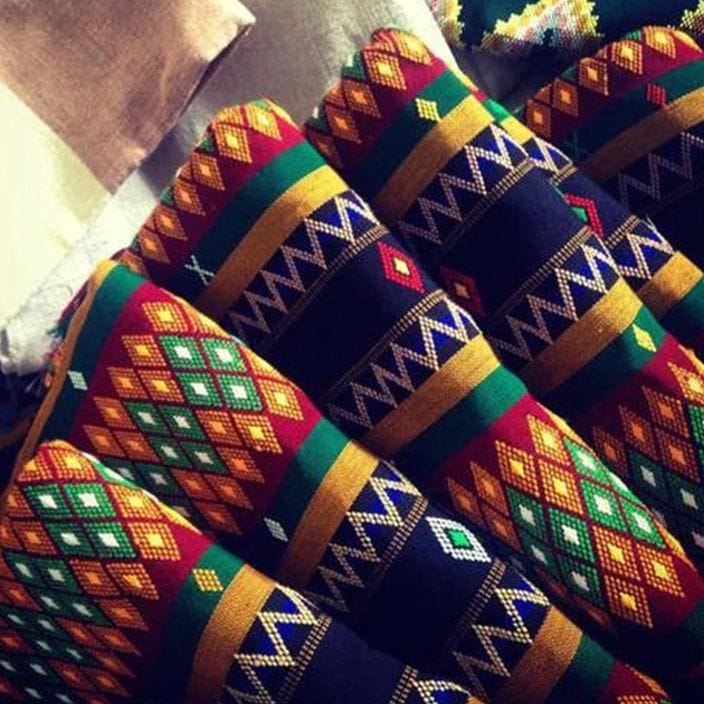For best prices and early deliveries, WhatsApp us at. 918488070070

Apatani
Originating from one of the state's tribes called the Apatani tribe, women weave this textile for occasions like weddings, rituals, and other cultural festivals, namely Dree and Myoko. The apatani fabric is primarily produced in Ziro, the district headquarters of the Lower Subansiri district, which is where the tribe takes residence. Known for following a sustainable social forestry system, the Apatani tribe ensures the same is done during weaving by using leaves and plant-based resources to naturally and traditionally dye yarn. They typically make shawls called 'jig-jagro' or 'jilan' and jackets called 'supuntarii.'
Tracing Its History
Like most tribes in Arunachal Pradesh, there is an inherent lack of authenticated records regarding the Apatani tribe's history. However, history has been recorded and remembered through the tribe's oral traditions or representations, performances, and culture. These representations are complex and diverse in nature.
Mainly, there are two oral genres — miji and migung. In miji, priests chant while sacrificing animals like cows, chickens, and pigs, called a ritual performance. These performances explain past interactions with gods or spirits and highlight origin myths. Migung is a bit more historical and is narrated through prose. The stories describe the tribe's origin, genealogy, migration, and urban legends connected to their occupation (weaving).
How It’s Done
Cotton, also known as 'empya' by the Apatani tribe, is abundant in their regions. To begin weaving the textile, raw cotton is spun to create a thread. In order to do this, the fibers are separated from seeds using a thin stick called lekho. This process is known as 'ginning.' The fibers are then shaped into a ball with a tafo, a spindle used to combine and twist the fibers together, creating thread or yarn. Once cotton fibers have become yarn, a wooden frame made of bamboo called hornanii is used to make loops. At this step, dyes can be added as per the desired outcome. Generally, vegetable-based dyes are made from plants like tamin, which provides a red-orange color, and sankhii, which produces a brown-yellow color. Balls are formed with the loops using a spinning wheel called piirii-e, and the yarn is finally ready to be woven into the beautiful Apatani textile with a back-strap tension loom.
The main tools for weaving are simply a collection of bamboo and wooden sticks that form a framework. First, a warp is formed by stretching the yarn between two parallel bamboo sticks. The warp is then passed on top of the bamboo, then under and over the lower end, and up and over the bamboo placed on the bottom.
This step is repeated until there is enough thread for the tribal women to weave with. Finally, the weft is threaded through the warp using a bamboo tube shuttle called lokho,' and a round stick is known as 'gochi nanii' is attached underneath the warp to support the woven fabric.
Design Elements
Designs in the Apatani textile are generally nature-inspired geometric designs or zig-zag and angular patterns. Traditionally, however, the designs are simple, with just straight lines as a characteristic that makes them stand out. For instance, there may be a series of bands with varying sizes running along the borders on the top and the bottom. Curved lines are hardly seen in this weave, but the shawl worn by the tribe's priests features a spiral design - some of which are curvy. Colors in this textile range from dull to bright, with black, red, yellow, blue, and orange being the predominantly used shades.
Apatani Textile Today
In Arunachal Pradesh, there are only two apatani tribes that have been granted the Geographical Indication (GI) status for their traditionally woven apatani fabrics. One of these tribes is the Apatani tribe, who applied for the tag in 2021. With the craft of their weaving slowly declining, it was essential for the tribe to take matters up to the legal level. This tag provides legal protection, prevents unauthorized use, and boosts textile exports. The benefits of the GI tag are far too many to ignore, as it assures that the tribal community's economy and occupation flourishes.
Several NGOs that focus on the north-eastern states of India have taken necessary steps to uplift the craft and maintain people's interest in it through workshops, seminars, or simple research studies that allow for a smooth flow of information. Therefore, it is hoped that the Apatani weave will gain popularity and become a favorite amongst households across the world with the right amount of dedication and interest.
The Apatani tribe of Arunachal Pradesh, India, is known for their expertise in sericulture, particularly the production of high-quality Mishmi and Muga silk, which are highly valued for their strength and sheen.
Image Credits
Art Lounge | The Wancho | Asia Inch | Cheeky Passports | Civils Daily | Google Arts & Culture | Guilame | IAS Toppers | Indigo Lion | Jatin Verma | Northeast Today | Rasmi Notes | Textile Of Arunachal Pradesh | Twitter | Woven Souls | Wrytin